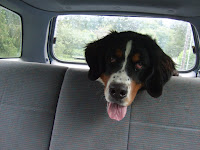 |
| DIA #1 of USA Fit Tri Training. |
 |
| Baby Sally. I know, it scares me, too. |
 |
| Look, Mom! A star chart! |
I don’t know if the star chart actually helped me lose my attachment to Baby Sally or not—I still own her germy remnants, after all—but the practice of keeping a record of my exercise and other goals is built into my infrastructure. Even during The Puffy Years, I recorded my infrequent visits to the gym, and now that serves as a reminder of just how much time I spent napping, snacking, drinking, and developing a soft cushiony spot at the top of my legs to decorate chairs with. I’m back on track now, however, keeping detailed, color-coded records of my work outs on a chart on the bedroom door so I can maintain a close watch on my strength-training, running, biking, and swimming.
But the truth is, as satisfying as it is to look at my calendar full of colored dots, other factors inspire me to DIA even more. “People can really only motivate themselves,” my dad reminds me, which is true, although we can certainly be open to examples set by those folks who are motivating themselves. At 71, my dad runs several times a week, and that’s in addition to the 2 or 3 soccer games he refs—he’s one of my greatest inspirations, someone who has told me on numerous occasions that he’s “always the same age inside.” He likes running and soccer, so he runs and refs soccer, and he serves as a perfect model of what it means to just be: to resist living in cautious trepidation that because of age you must not exert yourself. I’m following his example when I tell people that what I’m really training for is not triathlons, but to be a good old person: our bodies are our biographies.
 Reading helps me stay motivated, although there is a gaposis in the literature when it comes to triathlon. Except for the usual collection of how-to and how-to-do-it-even-better books, there isn’t much else; maybe because with three sports to train for, triathletes don’t have much time left over to write. The Grace to Race, by Sister Madonna Buder, is the only biography I’ve read about a triathlete, and her story is inspiring. She’s a nun! And she’s 81! And she’s completed over 200 triathlons, including 13 Ironman races! I don’t need Chicken Soup for the Lazy Triathlete’s Soul on my DIA days—I just need to chant Sister Madonna Buder Sister Madonna Buder Sister Madonna Buder a few times and suddenly my sloth-like ass is propelled out the bed and toward the gym.
Reading helps me stay motivated, although there is a gaposis in the literature when it comes to triathlon. Except for the usual collection of how-to and how-to-do-it-even-better books, there isn’t much else; maybe because with three sports to train for, triathletes don’t have much time left over to write. The Grace to Race, by Sister Madonna Buder, is the only biography I’ve read about a triathlete, and her story is inspiring. She’s a nun! And she’s 81! And she’s completed over 200 triathlons, including 13 Ironman races! I don’t need Chicken Soup for the Lazy Triathlete’s Soul on my DIA days—I just need to chant Sister Madonna Buder Sister Madonna Buder Sister Madonna Buder a few times and suddenly my sloth-like ass is propelled out the bed and toward the gym.I don't have a secret formula for overcoming DIA days; all I have is what seems to work right now. I have a plan, and it's specific and it's combined with a method--albeit an OCD one--for tracking my performance and my progress, and it includes rewards. Secondly, I have inspiration from people whose commitment to their physical selves gives me courage, strength, and a solid sense that age (as my dad says) "is only a number." Finally, and most importantly, I operate on the conviction that this is it: this is my one life, my one body, my one opportunity to take every piece of knowledge, physical strength, and determination that I have and use it to become the strongest person I can be. No Magical Buttock Fairy is going to arrive on my 45th birthday and grant me my Dream Ass. I have to work for it myself. And on days when I waver from that conviction, I think about my dad and Sister Madonna Buder, and Baby Sally. And I Do It Anyway.


